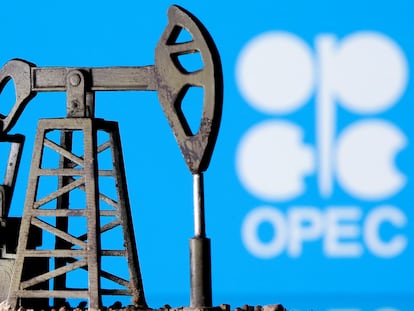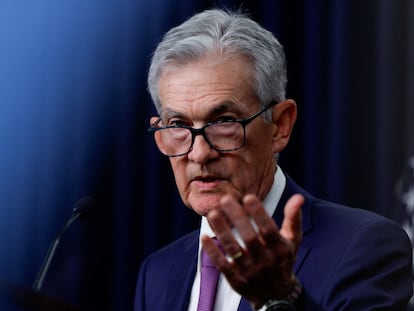An inflation gauge closely tracked by the Federal Reserve shows price pressures easing gradually
The government reported Friday that prices rose 0.3% from January to February, decelerating from a 0.4% increase the previous month in a potentially encouraging trend for President Joe Biden’s re-election bid

A measure of inflation that is closely tracked by the Federal Reserve slipped last month in a sign that price pressures continue to ease. The government reported Friday that prices rose 0.3% from January to February, decelerating from a 0.4% increase the previous month in a potentially encouraging trend for President Joe Biden’s re-election bid. Compared with 12 months earlier, though, prices rose 2.5% in February, up slightly from a 2.4% year-over-year gain in January.
Excluding volatile food and energy costs, last month’s “core” prices suggested lower inflation pressures. These prices rose 0.3% from January to February, down from 0.5% the previous month. And core prices rose just 2.8% from 12 months earlier — the lowest such figure in nearly three years — down from 2.9% in January. Economists consider core prices to be a better gauge of the likely path of future inflation.
Friday’s report showed that a sizable jump in energy prices — up 2.3% — boosted the overall prices of goods by 0.5% in February. By contrast, inflation in services — a vast range of items ranging from hotel rooms and restaurant meals to healthcare and concert tickets — slowed to a 0.3% increase, from a 0.6% rise in January.
The figures also revealed that consumers, whose purchases drive most of the nation’s economic growth, surged 0.8% last month, up from a 0.2% gain in January. Some of that increase, though, reflected higher gasoline prices.
Annual inflation, as measured by the Fed’s preferred gauge, tumbled in 2023 after having peaked at 7.1% in mid-2022. Supply chain bottlenecks eased, reducing the costs of materials, and an influx of jobseekers made it easier for employers to keep a lid on wage growth, one of the drivers of inflation.
Still, inflation remains stubbornly above the Fed’s 2% annual target, and opinion surveys have revealed public discontent that high prices are squeezing America’s households despite a sharp pickup in average wages.
The acceleration of inflation began in the spring of 2021 as the economy roared back from the pandemic recession, overwhelming factories, ports and freight yards with orders. In March 2022, the Fed began raising its benchmark interest rate to try to slow borrowing and spending and cool inflation, eventually boosting its rate 11 times to a 23-year-high. Those sharply higher rates worked as expected in helping tame inflation.
The jump in borrowing costs for companies and households was also expected, though, to cause widespread layoffs and tip the economy into a recession. That didn’t happen. The economy has grown at a healthy annual rate of 2% or more for six straight quarters. Job growth has been solid. And the unemployment rate has remained below 4% for 25 straight months, the longest such streak since the 1960s.
The combination of easing inflation and sturdy growth and hiring has raised expectations that the Fed will achieve a difficult “soft landing” — taming inflation without causing a recession. If inflation continues to ease, the Fed will likely begin cutting its key rate in the coming months. Rate cuts would, over time, lead to lower costs for home and auto loans, credit card borrowing and business loans. They might also aid Biden’s re-election prospects.
The Fed tends to favor the inflation gauge that the government issued Friday — the personal consumption expenditures price index — over the better-known consumer price index. The PCE index tries to account for changes in how people shop when inflation jumps. It can capture, for example, when consumers switch from pricier national brands to cheaper store brands.
In general, the PCE index tends to show a lower inflation level than CPI. In part, that’s because rents, which have been high, carry double the weight in the CPI that they do in the PCE.
Friday’s government report showed that Americans’ incomes rose 0.3% in February, down sharply from a 1% gain in January, which had been boosted by once-a-year cost-of-living increases in Social Security and other government benefits.
Sign up for our weekly newsletter to get more English-language news coverage from EL PAÍS USA Edition
Tu suscripción se está usando en otro dispositivo
¿Quieres añadir otro usuario a tu suscripción?
Si continúas leyendo en este dispositivo, no se podrá leer en el otro.
FlechaTu suscripción se está usando en otro dispositivo y solo puedes acceder a EL PAÍS desde un dispositivo a la vez.
Si quieres compartir tu cuenta, cambia tu suscripción a la modalidad Premium, así podrás añadir otro usuario. Cada uno accederá con su propia cuenta de email, lo que os permitirá personalizar vuestra experiencia en EL PAÍS.
¿Tienes una suscripción de empresa? Accede aquí para contratar más cuentas.
En el caso de no saber quién está usando tu cuenta, te recomendamos cambiar tu contraseña aquí.
Si decides continuar compartiendo tu cuenta, este mensaje se mostrará en tu dispositivo y en el de la otra persona que está usando tu cuenta de forma indefinida, afectando a tu experiencia de lectura. Puedes consultar aquí los términos y condiciones de la suscripción digital.
More information
Archived In
Últimas noticias
Most viewed
- Sinaloa Cartel war is taking its toll on Los Chapitos
- Reinhard Genzel, Nobel laureate in physics: ‘One-minute videos will never give you the truth’
- Oona Chaplin: ‘I told James Cameron that I was living in a treehouse and starting a permaculture project with a friend’
- Why the price of coffee has skyrocketed: from Brazilian plantations to specialty coffee houses
- David King, chemist: ‘There are scientists studying how to cool the planet; nobody should stop these experiments from happening’










































